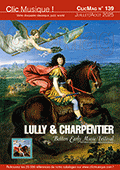 Madame de Maintenon souhaitait un opéra auquel Racine et Lully auraient collaboré : elle dut se contenter de "L’Idylle sur la paix", une sérénade aux vers chantants que Lully théâtralisa à sa façon. Créée à Sceaux, en 1685, chez le marquis de Seignelay, l’œuvre séduisit immédiatement le Roi-Soleil, qui en admira surtout la dernière section : divin trio « Ô ciel, ô saintes destinées », suivi du chœur « Qu’il règne ce héros » et d’une admirable chaconne. Adopté par le public, l’ouvrage servit souvent par la suite de prologue aux tragédies lyriques. "La Fête de Rueil", contemporaine, ne connut pas la même fortune : Louis XIV ayant annulé sa visite à Rueil, chez le duc de Richelieu, l’œuvre ne fut pas donnée. Quel dommage ! Sur un prétexte galant (la bergère Iris refuse de tomber amoureuse), Charpentier y convoque pâtres, satyres et diseuse de bonne aventure, dans un style plus italien et raffiné que celui de son rival. Spécialistes des deux compositeurs, les musiciens de Boston, après "Psyché" de Lully et "Les Arts Florissants" de Charpentier, ressuscitent deux partitions rarissimes. (Olivier Rouvière)  On August 15, 1684, the Sun King’s war against Emperor Leopold I and King Charles II of Spain reached a temporary end. Louis XIV had secured the advantage, and so several influential gentlemen sought to delight His Majesty with extravagant tributes. One of them was the Marquis de Seignelay, who spent the staggering sum of 100,000 livres on illuminations, lavish banquets, and a concert at his Château de Sceaux on a summer evening. In doing so, he sparked a sensation that echoed for years: the Idylle sur la Paix (Idyll on Peace), featuring music by the court composer Lully and poetry by the court poet Racine. The Duke of Richelieu (the great-nephew of the legendary Cardinal) could only remain in second place. He, too, had planned a grand fête at his estate, with music by Marc-Antoine Charpentier and the unveiling of an equestrian statue of the king. But the devil lurked in the details, and the Fête never came to pass. Now, 340 years later, the Boston Early Music Festival brings this long-lost vision to life.
 |
